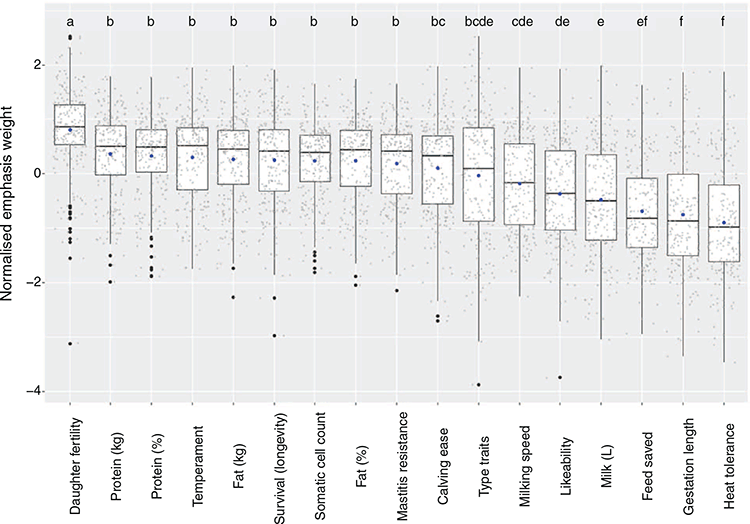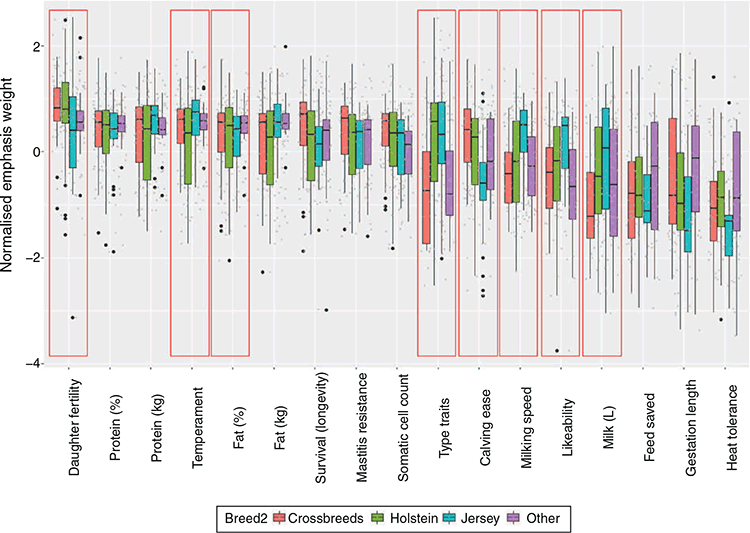Impact of a multiple-test strategy on breeding index development for the Australian dairy industry
Michelle Axford A B C E , Bruno Santos D , Katarzyna Stachowicz D , Cheryl Quinton D , Jennie E. Pryce
A B C E , Bruno Santos D , Katarzyna Stachowicz D , Cheryl Quinton D , Jennie E. Pryce  B C and Peter Amer D
B C and Peter Amer D
A DataGene Ltd, 5 Ring Road, Bundoora, Vic. 3083, Australia.
B School of Applied Systems Biology, La Trobe University, Bundoora, Vic. 3083, Australia.
C Agriculture Victoria, AgriBio, Centre for AgriBioscience, Bundoora, Vic. 3083, Australia.
D AbacusBio Limited, PO Box 5585, Dunedin 9058, New Zealand.
E Corresponding author. Email: maxford@datagene.com.au
Animal Production Science - https://doi.org/10.1071/AN21058
Submitted: 10 February 2021 Accepted: 12 July 2021 Published online: 6 September 2021
Journal Compilation © CSIRO 2021 Open Access CC BY
Abstract
Context: A high level of acceptance and use of breeding indices by farmers and breeding companies that target a National breeding objective is an effective strategy to achieve high rates of genetic gain. Indices require maintenance to ensure that they reflect current economic and genetic trends and farmer preferences. Often, indices are tested on an average herd on the basis of, for example, milk composition and calving pattern. However, this strategy does not differentiate the impact on breeds. Australian dairy farmers routinely make breeding decisions by using the balanced performance index (BPI) or the health weighted index, published by DataGene.
Aims: The aim of the present study was to test new selection indices on the most popular breeds to better understand the genetic progress that each breed is expected to make. Existing economic models were updated to reflect changing trends in input costs and milk income. Consultative processes identified opportunities to improve alignment between farmer preferences and Australia’s National Breeding Objective. In response, more than 20 selection index options were developed and options were discussed with industry.
Methods: Indices were evaluated on three breeds in the following three ways: (1) expected response to selection from the use of each index, (2) index and trait correlations, and (3) relative trait emphasis.
Key results: Farmer trait preferences varied by breed and this information was considered in the development of economic weights. The updated BPI has primary emphasis on production traits (44% in Holstein, 49% in Reds), secondary emphasis on health and fertility (35% in Holstein, 29% in Reds), tertiary emphasis on type, workability and feed saved. The equivalent index for Jerseys is similar, but following stakeholder feedback to multiple tests, it was decided to remove emphasis on the feed saved estimated breeding values, so that the percentage emphasis on trait groups in Jerseys is 51% production, 32% health and fertility and the remainder on type and workability.
Implications: Understanding trait preferences and testing indices on different breeds can change the decisions that are made during index development.
Conclusions: Developing a better understanding of the differences among breeds had a positive impact on farmer engagement and resulted in a modified BPI for the Jersey breed.
Key words: dairy selection index, breeding objective, trait preference.
Introduction
In Australia, the National breeding objective (NBO) aims to define a single breeding goal against which genetic gain can be measured in the dairy industry. Broadly speaking, the goal is to increase net profit (Byrne et al. 2016; Newton et al. 2021), which is defined as the margin between milk and livestock income over feed and herd costs. It is expressed as A$ profit/cow.year in Australia’s production environment. Dairy farmers routinely make breeding decisions by using the balanced performance index (BPI) or the health weighted index (HWI), and to a lesser extent, the discontinued type weighted index (TWI), published by DataGene (www.datagene.com.au). The BPI is the primary economic breeding index that ranks animals according to the NBO and is in line with farmer preferences. The HWI is a desired gains index that reflects the preferences of farmers seeking greater focus on functional traits (Byrne et al. 2016). Farmer trait preferences have been described in previous research articles (Martin-Collado et al. 2015).
In countries with established dairy industries, the use of a national breeding goal and implementing agreed indices has proven to be highly effective in focusing commercial breeding programs and on-farm breeding decisions so that high rates of genetic gain can be achieved across a population (Van der Werf 2019). However, the Australian population is made up of more than 5000 individual businesses that operate in their own unique climatic and economic environment (Dairy Australia 2021) and this can influence breeding preferences. Farmers that operate these businesses express a variation in their trait breeding preferences (Martin-Collado et al. 2015). As a result, it is common for businesses to superimpose their own unique trait preferences into their selection decisions as a deviation from the NBO.
One variable that can vary among businesses is the breed composition. DataGene national herd recording statistics report that 72% of the cows with a known breed are Holstein, followed by 15% Jersey, 5% Holstein × Jersey cross, 4% Australian Red Breed (DataGene 2020a). Semen sales are reported, annually, by breed. Consistent with the national herd recording statistics, Holstein semen is used most widely (81% of sales), followed by Jersey (12%) and Australian Red Breed (3%; NHIA 2020). As non-Holstein breeds comprise 28% herd-recorded cows and 19% semen doses, it is important to consider breed differences in the development of National breeding indices.
The present study explores differences among farmers in their attitudes towards and use of indices. It describes newly updated Australian breeding indices and the impact of a multiple index testing strategy applied to the most popular breed groups.
Materials and methods
The BPI and HWI indices were updated following a review that included the calculation of economic values of selected traits using updated data, comprehensive index testing and considered feedback obtained through industry survey and consultative activities. In contrast to previous NBO reviews, index options were tested on three breed groups and this had a material impact on the agreed indices implemented in December 2020. The purpose of the present paper is to describe how the industry survey, development of economic values and testing of index options led to breed variation in the agreed BPI.
Survey
Involving stakeholders in the development of the NBO and decisions that change breeding indices has proven to be a highly valued strategy that increases the awareness and use of indices in Australia (Martin-Collado et al. 2015). The industry consultation process of the NBO review was guided by DataGene Genetic Evaluation Standing Committee. This committee has been in place since the inception of DataGene in 2016 and comprises farmers, breeding companies, researchers and industry representatives. The committee plays a vital role in prioritising and overseeing development and extension activities that deliver better herd-improvement services to Australian farmers. The committee set the scope of the NBO review, guided the consultation process, reviewed index options and, ultimately, agreed on the final indices (DataGene 2020b).
Surveys can be an efficient method of involving end users in decision-making processes. In this case, a voluntary, on-line survey of farmers and other industry stakeholders was conducted. The survey approach utilised Alchemer (formerly SurveyGizmo) software to capture socio-demographics characteristics of respondents, as well as respondents’ views, perceptions, and preferences for traits and indices (Alchemer 2019). The analysis of survey outputs was used to understand farmer preferences and prioritise traits for improvement according to market needs and user profiles. The outcomes of the survey were then specifically used to inform the modelling that determined the economic value of traits and inform the modifications to the reviewed indices.
The on-line survey was conducted from 9 December 2019 to 5 February 2020. The survey was distributed to dairy farmers and industry stakeholders. In total, 24 questions were asked. Respondents were asked about their business activity, region, farm size, breed, payment system, feeding system and calving pattern. Some questions asked for views and opinions about index acceptance and use, as well as several current issues. Trait preferences were gathered using two types of question. The first was a simple scale from ‘not important’ to ‘very important’, while the second asked the respondent to trade-off one trait against other traits of a similar economic value. In total, 341 responses were received, including 254 where the survey was fully completed. Of the 254 completed surveys, 161 were farmers. Respondents represented all sectors of the industry as well as the regions and dairy farming systems found in Australia. While the survey data contributed a comprehensive set of data to the NBO review, the present paper focuses mainly on results that pertain to breed.
Developing economic values
A bioeconomic model was used to calculate index trait economic weights using the foundations developed in 2015 (Byrne et al. 2016). Some inputs and calculations were updated. The major changes were milk prices; fat price increased by A$0.41–3.63/kg; protein price decreased by A$0.71–7.26/kg; volume price increased by A$0.04–0.46/L; and solids price increased by A$0.47–6.18/kg. Feed cost increased by A$0.007/MJ of ME to A$0.032/MJ of ME. Replacement heifer cost increased by A$44–1650/head. Labour costs increased by A$6.75–36.75/h. Average cow milk composition was updated. Fat percentage decreased by 0.02 percentage points and protein percentage increased by 0.04 percentage points. Average milk volume increased by 137 L/lactation. Herd structure, mating and AI costs, conception rates, survival rates by lactation, rearing heifer non-feed costs, somatic cell count (SCC), milk quality band incentives, mastitis and antibiotic costs were kept the same as in the 2015 model (Byrne et al. 2016). Several trait genetic and phenotypic parameters (genetic and phenotypic variances, heritability, genetic correlations) have also been updated with values from more recent data for bulls with Australian performance information.
In Australia, estimated breeding values (known as Australian breeding values; ABVs) for dairy cattle are routinely predicted by DataGene on a weekly basis, with official public releases in April, August and December. The updated version of the model used by Byrne et al. (2016) was used to calculate economic values and economic weights for the following ABVs: production (milk protein, milk fat, milk volume), health and fertility (survival, daughter fertility, SCC, mastitis resistance), workability (milking speed, temperament), type (mammary system, udder depth, overall type, pin set, fore-udder attachment) and feed saved. Feed saved is a breeding value comprising bodyweight, accounting for energy requirements for maintenance (all breeds) and residual feed intake for the Holstein breed (Pryce et al. 2015).
Compared with the 2015 indices, several updates have been made to the traits included and economic weight calculations. A key change was reinstating the survival ABV instead of residual survival ABV; this decision was made because of instability in residual survival ABVs in routine genetic evaluation runs performed by DataGene. Although the survival ABV is included in its own right in the 2020 set of indices, several other traits retain an economic value component attributable to survival, including SCC, mastitis resistance, daughter fertility; also, overall type, pin set and fore-udder attachment economic values are based on relationships with survival. Mastitis resistance ABVs were released for the first time in 2020 and have been included in the indices; details of the model and development of this ABV are described by Abdelsayed et al. (2018). Udder depth is retained as a defined ABV trait in the model used to derive weights in the BPI/HWI, despite its economic value being derived exclusively from its relationship with clinical mastitis. This is an outcome of a consultative process involving key stakeholders, because end users were reluctant to accept a decline in the economic value of udder depth compared with previous indices. Daughter fertility economic weight calculations were defined for BPI assuming 36% seasonal calving, 43% split calving and 21% year-round calving systems, and for HWI assuming 100% seasonal calving.
The new economic weights based on the 2020 version of the Byrne et al. (2016) model were used to calculate an updated BPI, HWI and TWI, as well as a further 17 variations that responded to the feedback gathered through the survey process and subsequent consultation. To form the proposed and final 2020 indices, adjustment factors were implemented to convert the 2020 model economic weights to index economic weights, as described by Byrne et al. (2016). For the proposed indices, these adjustment factors were derived from comparison of 2019 BPI, TWI and HWI economic weights with 2015 model economic weights. Adjustment factors for the final indices are based on proposed indices, with some further agreed modifications. Final 2020 index adjustment factors and final economic weights are presented in this paper. Some variations became index options for consideration, while others were used simply to illustrate extremes (DataGene 2020b).
In line with the indices available to farmers between 2015 and 2019, the BPI index was targeted at farmers with the goal of greatest gains in production traits, balanced with improving or maintaining health and fertility, with some emphasis on type and feed saved. It is an economic index with its objective to increase the margin between milk and livestock income over feed and herd costs and is in line with farmer preferences. The HWI index is aimed at farmers, with goals of greater gains in health and fertility, improving or controlling loss in feed efficiency, balanced with production. The TWI index which focussed on type traits was agreed to be discontinued due to low usage.
Index testing
Compared with past reviews, index testing was broadened to include genetic evaluation data from Holstein, Jersey and Red bulls. All index variations were tested and compared with the indices routinely evaluated by DataGene before the NBO review, referred to as 2019 indices. Tests were designed to identify traits with strong relationships to the indices, correlate index values to predict re-rankings with proposed indices and predict responses to selection using correlations among ABVs and scaled to be equivalent to a 1 standard deviation (s.d.) change in the index tested.
As fertility is a low-heritability trait, it has lower reliabilities than do many of the other ABVs evaluated by DataGene; consequently, fertility was chosen as the trait to select a minimum acceptable reliability of ABV. Furthermore, the smaller populations of Jerseys and Reds mean that these breeds generally have lower reliabilities than do Holsteins. Index options were tested with ABVs from three sets of bulls, born between 2011 and 2015, using the following reliability criteria:
-
Holstein, minimum reliability of daughter fertility ABV 60%, n = 9283
-
Jersey, minimum reliability of daughter fertility ABV 50%, n = 1067
-
Reds, minimum reliability of daughter fertility ABV 50%, n = 699; Reds include Aussie Red, Ayrshire, Illawarra and Shorthorn sires.
The s.d. values of ABVs were calculated from the ABVs of the three sets of bulls. For all tested indices, the proportion of relative emphasis of each trait in an index was calculated as follows:
-
For each trait, calculate relative economic weight (REW) = index EW × ABV s.d., then take the absolute value |REW|
-
For each index, sum all trait absolute REW =

-
For each trait, the proportion or relative emphasis =

Correlations among indices were calculated using these three sets of bulls. In addition, correlations between indices and 45 ABV traits were calculated.
Relative emphasis was also expressed by trait groups production (protein, fat, volume), health & fertility (survival, daughter fertility, SCC, mastitis resistance), workability (milking speed, temperament), type (mammary system, udder depth, overall type, pin set, fore-udder attachment), and feed saved.
Individual trait responses to selection with index options were calculated as per Byrne et al. (2016), by regressing trait ABV separately on index values. Responses are presented for a level of selection intensity that would achieve 1 s.d. of change in the 2019 BPI (BPI19).
All 2020 variations were tested and compared with 2019 indices. Tests were designed to identify traits with strong relationships with indices, correlate index values to predict the extent of re-rankings that would occur when switching among various proposed indices, and to predict responses to selection. Testing was also broadened to include genetic evaluation data from Holstein, Jersey and Red bulls.
Results and discussion
Survey
More than half (52.5%) farmer responses reported Holstein to be the main breed of cows milking in their herd, while 19.7% reported two-way or three-way crossbred, 16.4% Jersey and 4% Aussie Red in the industry survey. Compared with the composition of herd-recorded cows and semen sales, survey responses from farmers with Jersey and crossbred cows were over-represented and fewer Holstein responses were returned. However, the sheer size of the Holstein breed compared with smaller breeds means that the diversity of views within the breed is most likely to be captured. In fact, having proportionally more responses from smaller breeds is an advantage to better understand farmer views.
The survey respondents were very positive about the BPI. Only 30% of all respondents did not think that it is the best way to rank bulls for profit. When asked which Australian indices are most useful for the operation, only 22% responded that none was useful. This result is in line with trends identified in a complimentary 2019 Animal Husbandry and Genetics Survey of randomly selected farmers that reported an increase in awareness of BPI/HWI/TWI from 65% to 80%, compared with 2016 (Watson and Watson 2019). In the same study, Watson and Watson reported that 48% of all respondents use at least one Australian index. This is lower than in the current study, suggesting that the voluntary nature of this survey attracted farmers who are more interested in Australian indices and possibly interested in genetics. The survey of Watson and Watson (2019) collected more detailed demographic data and reported that the use of at least one index varied by herd size (56% of extra-large to 32% of small herds). Similarly, 59% of those aged 18–39 use at least one index, compared with a much lower 39% of those aged 60+. Among those using BPI, HWI or TWI, almost all (94%) said they have ‘a lot’ (50%) or ‘a little’ (43%) influence on semen purchases (Watson and Watson 2019).
Respondent attitudes to the main indices are summarised both across and within breed groups in Table 1. Red and Jersey respondents were the most supportive of the BPI and crossbreed respondents the least supportive, as shown in Table 1. Crossbreed respondents tended to find HWI more useful than did purebred farmers and more often disagreed with the statement ‘Australian indices include all traits important to me’. One possible explanation of this view could be that they feel that the indices are aimed at purebreds, not crossbreds.

|
Jersey respondents that disagreed or strongly disagreed with ‘BPI is the best way to rank bulls for profit in Australia’ were asked to explain the reasons for their response. While the responses were varied, the most common responses included ‘index instability’, ‘desire for a big Jersey cow with high milk component yields’, ‘not convinced of its usefulness’, ‘not an accurate indication of the quality of a herd’ and ‘require more emphasis on fertility and survival’.
Interestingly, the reasons for respondents with two-way and three-way crosses disagreeing with this same statement were less varied. Predominantly, their reasons were ‘not an accurate indication of the quality of a herd’, ‘use other countries’ indices’ and ‘not convinced of its usefulness’.
Thirty-five per cent of respondents supported an increased emphasis on feed saved. Red respondents were most likely to support the greater emphasis on feed saved in Australian breeding indices. Jersey respondents were similar to other breed respondents in the proportion of ‘agree’ or ‘strongly agree’; however, they were more likely to ‘disagree’ or ‘strongly disagree’ (38%). This is in alignment with comments in the open-ended questions that indicated a desire to breed larger, higher-yielding Jerseys as feed saved is negatively associated with liveweight.
In general, the analysis of desired traits emphasis concluded that respondents would give the highest emphasis to daughter fertility and the lowest to feed saved, gestation length and heat tolerance (Fig. 1). Two large groups of traits can be statistically differentiated. The group which is second in desired emphasis (behind daughter fertility) is formed by the following 10 traits (protein (kg), protein (%), temperament, fat (kg), survival (longevity), SCC, fat (%), mastitis resistance, calving ease, and type traits), which, given the wide distribution of weights, cannot be statistically differentiated from each other. Finally, in a third position of desired emphasis are the traits of milking speed, likeability and milk (L).
The study evaluated the variation of desired traits emphasis across breeds (Fig. 2). Jersey farmers showed differences, in their desired emphasis on several traits, from Holstein and Crossbreed farmers (Fig. 2). Jersey farmers gave more emphasis to temperament, fat (kg), milking speed and likeability and less emphasis to daughter fertility and calving ease than did Holstein and Crossbreed farmers. Variation among breeds has been observed by Paakala et al. (2018) for sire selection profile, by Fuerst-Waltl et al. (2016) for desired trait emphasis and by Slagboom et al. (2016) for trait preference. Finally, type traits are more important for Holstein and Jersey farmers than to crossbreed farmers. The different emphasis on type traits might be related to the fact that most crossbreed farmers (84%) are non-registered farmers. Registered farmers would give less emphasis to calving ease, milking speed, milk (L) and gestation length and more emphasis to type traits than do non-registered farmers. Note that ‘registered farmers’ refer to farmers whose herd is registered in a breed society regardless of the proportion of animals registered.
Economic weights
Economic weights for index traits calculated with the 2020 NBO model trait are summarised in Table 2 for the final indices. The final 2020 BPI referred to as BPI20 has been calculated for all non-Jersey breeds and is published by DataGene as BPI. The final 2020 BPI for Jerseys, referred to as BPIJe20, has been calculated only for Jerseys and is also published as BPI. The final 2020 HWI, referred to as HWI20, has been calculated for all breeds and is published as HWI.
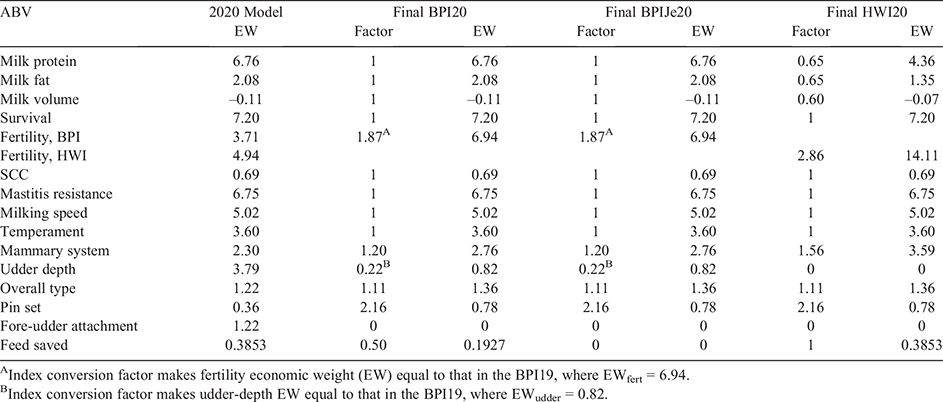
|
Index testing
Index correlation
Correlations among bull index values with 2019 and final 2020 indices are shown in Tables 3–5 for Holstein, Jersey and Red bulls respectively. Substantial re-ranking is expected with 2020 BPI and HWI, compared with the 2019 equivalents. The 2020 BPI and HWI also differ more than do the 2019 equivalents, due to extra emphasis on daughter fertility in the 2020 HWI. The correlation between 2020 BPI and HWI is lowest in Reds, compared with Holstein and Jersey, suggesting substantial re-ranking, which is likely to be an artefact of the smaller population size than Holsteins and Jerseys. Index values with the 2020 Jersey BPI are highly correlated with the all-breed BPI, but some re-ranking is expected due to zero weighting on the feed saved EBV.
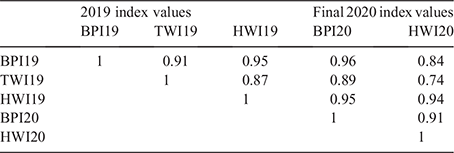
|
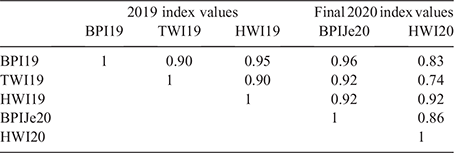
|
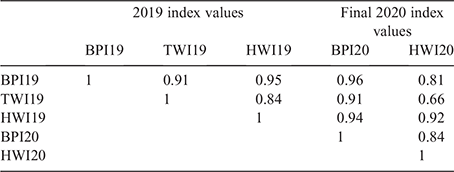
|
Relative emphasis
Relative emphasis of traits in the 2020 indices is shown in Table 6. The BPI20 still has primary emphasis on production traits (44% in Holstein, 49% in Reds), secondary emphasis on health and fertility (35% in Holstein, 29% in Reds), tertiary emphasis on type (9% in Holstein and Reds), workability (6% in Holstein, 8% in Reds) and feed saved (5% in Holstein and Reds). The BPIJe20 is similar, but with no emphasis on feed saved (51% production, 32% health and fertility, 11% type, 6% workability in Jerseys).
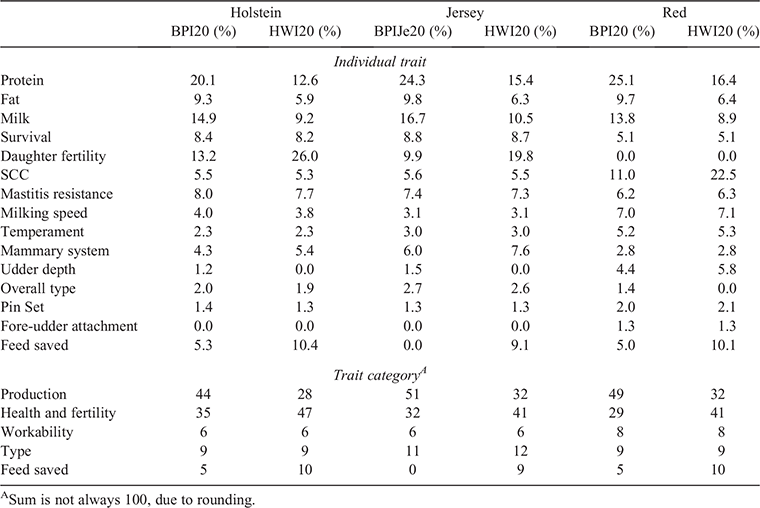
|
The HWI20 does change trait emphasis compared with HWI19. The HWI20 has primary emphasis on health and fertility (47% in Holstein, 41% in Jersey and Reds), secondary emphasis on production (28% in Holstein, 32% in Jersey and Reds), tertiary emphasis on both feed and type (9–10% in Holstein and Reds, 9–11% in Jersey), and remainder on workability (6% in Holstein and Jersey, 8% in Reds). In contrast, the HWI19 had primary emphasis on production (36% in Holstein, 40% in Jersey, 38% in Reds), secondary emphasis on health and fertility (29% in Holstein, 24% in Jersey, 27% in Reds).
Predicted responses to selection
Predicted responses to selection with the three 2020 indices are summarised in Table 7 for Holstein, Jersey and Red bulls. Responses in other evaluated traits were also predicted, but are not presented in this paper.
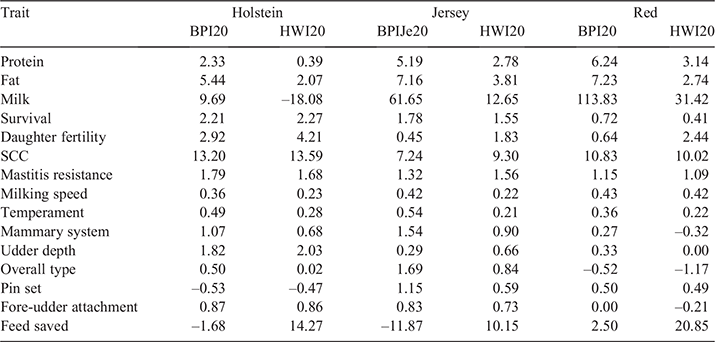
|
Generally, compared with the BPI19, the BPI20 is predicted to have substantially higher gains in survival, SCC and mastitis resistance, greater fertility gain, greater gains in most type traits, and reduced loss in feed efficiency. These gains have trade-offs of reduced gains in production traits, but production is still predicted to improve.
For farmers using BPI, the BPI20 is similar in that it still has primary emphasis on production traits, secondary emphasis on health and fertility, tertiary emphasis on type, and remainder on workability and feed efficiency. However, by adding in survival (instead of residual survival) and mastitis resistance, the BPI20 does apply greater emphasis on health. This caused some re-ranking of bulls, by raising the ranking of bulls with superior survival and/or mastitis resistance ABVs (these bulls still need good production ABVs to reach top ranking). While residual survival is theoretically superior to survival, as it avoids double-counting of traits genetically correlated with survival, such as, for example, fertility and mastitis resistance, it exhibits instability in routine genetic evaluations. However, as animal welfare is a high priority for the dairy industry, this sort of double-counting is deemed to be acceptable and actually means that both BPI and HWI are to some degree desired-gains approaches.
Selection with the BPI20 in Holsteins is predicted to make greater gains in survival, SCC and mastitis resistance, fertility and most type traits, and minimise feed efficiency loss through control of liveweight. These gains do have the trade-off of reduced gains in production traits, but production is still predicted to improve. Similar responses are predicted for Reds, but with some differences due to different trait correlations; notably, fertility gains are reduced slightly, and feed saved is predicted to improve.
For Jersey farmers, the BPIJe20 has some differences from the all-breed BPI. As with the all-breed version, higher rankings are expected for bulls with superior survival and/or mastitis resistance ABVs, with associated greater gains in survival, SCC and mastitis resistance, fertility, and most type traits. However, because the BPIJe20 does not penalise low feed efficiency, it will also allow bulls with high liveweight ABV (low feed efficiency) to rank highly if they have good production and health and fertility. Because liveweight has positive genetic correlations with production traits, releasing the feed efficiency/liveweight restriction in the BPIJe20 is predicted to double gain in milk volume compared with the all-breed BPI (but similar gains in protein and fat), with trade-off of less feed efficiency. Liveweight gain is predicted to more than double. The direction of the BPIJe20 is in line with the feedback of Jersey farmers, while maintaining an index that is still highly correlated with the all-breed BPI (0.99 in Jersey bulls). While removing the feed saved ABV from the BPIJe20 may mean that there is a reduction in selecting for efficiency of production in the Jersey breed, it is important to remember that ignoring the wishes of farmers may substantially reduce the uptake and use of the index. We will return to this point later.
Compared with the HWI19, the HWI20 is predicted to have higher gains in survival, fertility, mastitis resistance, feed saved, and some type traits. Again, there are trade-offs in production, with reduced gains in protein and fat, and milk volume is predicted to decrease. Milking speed and temperament are also predicted to have reduced gains.
For the smaller proportion of farmers using the HWI, the new HWI20 does have a major change in that fertility has the highest emphasis, shifting primary emphasis to health and fertility, while production is secondary. This will cause some substantial re-ranking of bulls, by raising ranking of bulls with superior daughter fertility ABVs and reducing the influence of production ABVs. It is expected that this will attract farmers that currently use evaluations from other countries that place a perceived stronger emphasis on health and fertility.
The approach used in the present paper was to examine responses to selection by using bull breeding value lists. There are alternative methods to index testing, such as using established genetic parameters to predict response to selection, as described by Falconer and Mackay (1996). However, this method requires accurate genetic parameters for each index trait. Haile-Mariam and Pryce (2015) observed that genetic parameters can change over time, which creates practical challenges for ensuring accurate genetic parameters for all traits and breeds relevant to the population under selection. Differences between estimates of genetic parameters can also influence the response prediction (Fuerst-Waltl et al. 2016). Using genetic parameters may be more relevant for an entire population but may be less accurate to correctly evaluate the population under selection. Index testing methods that rely on the proofs of bulls in use is one way to avoid this issue and is likely to result in more realistic responses to selection within breed, especially as sire selection pathways are a major driver of genetic gain.
Practical implications
What an index is, what it does and what it does not do can differ by breed, this is because correlations between ABVs and indices vary among breeds and, consequently the anticipated response to selection. Haile-Mariam et al. (2013) found that genetic correlations among traits vary between Holstein and Jersey breeds; for example, the genetic correlation between fertility and survival were the same magnitude but of different signs (i.e. that cows with genetically longer calving intervals were more likely to be culled in Holsteins and Jersey cows with a higher genetic potential for milk yield were more likely to survive). In some cases, the differences are subtle and can be ignored. In other cases, the story is vastly different. Ignoring breed differences risks alienating the end users of an index which reduces index acceptance, use and, subsequently, genetic gain for the breeding objective. Ignoring differences risks missing unintended consequences of selection. Investing in a thorough understanding of breed differences during index reviews presents opportunities to better predict the strengths (and weaknesses) of future herds, enables valuable information exchange during consultation, and supports stakeholders by providing highly relevant data so that they can achieve their goals.
The communication of indices becomes more complicated with the adoption of a multiple-test strategy. Which ‘result’ presents the clearest and most concise information for farmers? Internationally, relative emphasis is referred to as percentage emphasis and is commonly used to compare indices in the popular press (Schneider 2019). Relative emphasis in selection indices is based on a simple multiplication of the relative contribution of the economic value of each trait (converted to absolute value) and its genetic s.d. Despite debate about the validity of this approach (Leitch 1994; Cunningham and Tauebert 2009), it is a common method to compare indices among countries and breeds (Miglior et al. 2005; Cole and VanRaden 2018). Among breeds, there are differences in relative emphasis on trait groups influenced by differences in s.d. values of ABVs; for example, the widely reported deterioration in fertility in Holsteins (Berry et al. 2014) has resulted in more variation in EBVs for Holsteins than for Jerseys. In the December 2020 genetic evaluation of DataGene, the s.d. values of daughter fertility ABVs were 6 and 4 for Holsteins and Jerseys respectively.
In Holsteins, 44% of the comparative emphasis BPI20 is on production traits, but this figure is closer to 49% in Jerseys and Reds, whereas the weighting on health is 35% in Holsteins and closer to 30% in Jerseys and Reds. This is comparable to other countries; for example, the Canadian LPI and US NM$ have ~50% emphasis on production traits (Cole and VanRaden 2018). Without an understanding of differences among populations, it can be challenging for farmers to resolve why emphasis is different, despite equivalent economic weights. In a second example, the relative emphasis analysis suggests that there is a 9% emphasis on type traits; however, the response to selection for overall type is negative (unfavourable) in Reds (–0.52 units/1SD BPI) as this trait is mildly or moderately antagonistic to traits of higher values such as protein, SCC, mastitis resistance, daughter fertility and feed saved. This same story is not true for Holsteins and Jerseys. A simpler approach would be to test indices on the largest breed. However, these examples highlight the additional insight provided by a multiple-test strategy on different breeds, despite the communication challenges they introduce.
Stakeholders involved in genetic improvement appreciate data that provide a greater insight into breed trends. Especially when this enables the measurement of progress and calculating the value of improvement (Newton et al. 2021), but also to avert disasters such as the historical decline in female fertility during the 1990s and early 2000s (Berry et al. 2014). The survey data reported in the present study show that crossbreed farmers are less likely to use Australian indices than are farmers with other breeds because they place a greater value on indices from other countries. This insight presents an opportunity for further investigations to identify development and extension activities that better cater to the needs of this audience. In a second example, the predicted response for liveweight is nearly three times as large for the Jersey breed applying the BPIJe20 index than those with the BPI20. This is explained by the exclusion of feed saved, and its negative association with liveweight from the BPIJe20. Through the survey and subsequent consultation, Jersey farmers expressed a strong desire to increase the size of their cattle because their experience has shown that larger cattle are better able to compete in mixed breed and crossbred herds. This adjustment to the index was identified because predicted responses were calculated for multiple breeds. In a third example, the predicted responses for mammary system and overall type are negative when applying the HWI20 to Reds and survival is predicted to improve only slightly. This seems to be a trade-off with the improved predicted responses for daughter fertility compared with BPI20. While survival is heavily influenced by fertility (Berry et al. 2014), and even more so in Holsteins (Haile-Mariam et al. 2013), there are other reasons why cows do not last in a herd. There is a risk that deteriorating udder quality could increase earlier age at culling within this breed, if left unchecked.
Enthusiast breeders, sire analysts and breed organisations value individual traits not only for direct improvement, but also their indirect improvement of important traits. For example, mastitis resistance is valued very much in conjunction with some indirect traits with positive associations (e.g. SCC, udder depth, front teat placement and fore-udder attachment). In a second example, chest width is a widely discussed trait in the popular press and within commercial breeding organisations (Poelman 2020), as farmers express concern about the narrowing of chest width in recent years. Using the ABVs in our dataset, chest width is negatively correlated with survival (–0.31), daughter fertility (–0.17) and mastitis resistance (–0.13). Although Haile-Mariam and Pryce (2015) found that body depth (correlated with chest width) has changed from a zero correlation with survival (early 1990s) to negative (late 1990s), implying that selection may be altering these relationships over time. As survival and daughter fertility traits have increased their economic weight in recent indices, the genetic trend for chest width trait has declined. In the present study, the predicted response in Holsteins is a modestly negative decline in chest width over time (0.86 ABV/1 s.d. change BPI) using the BPI20. However, will there be a point when chest width is perceived to be too narrow and begins to negatively affect other traits that currently attract an economic weight? For this reason, it is likely that this trait will attract more attention. In total, 14 of the 50 traits for which ABVs are calculated attract an economic value in the new indices. This does not mean that the remaining traits are unimportant. Genetic evaluation units that are responsible for producing and maintaining national indices should expect more requests for trend and predicted response data at a trait level. Index reviews provide a timely opportunity to check for unintended consequences of a particular selection direction on traits within breeds with sufficient data.
One limitation of within-breed analysis is the availability of data for smaller breeds. In the case of Jersey and Red breeds, it is likely that the choice of filter to select sire lists used to calculate correlations and predicted response to selection could influence the results. A different choice of filter could leave a different impression of the relevance or value of an index. Furthermore, some breeds are too small to analyse. For example, individual breeds within the Red group (such as Illawarra), as well as breeds such as Guernsey and Brown Swiss, are not sufficiently large, in Australia, to confidently analyse.
Continued efforts to monitor the adoption and use of indices following their implementation is vital. This will be particularly important to judge the ongoing success of a multiple-test strategy. Long-term, standardised surveys such as Dairy Australia’s Animal Husbandry and Herd Genetics survey provide a good understanding of attitudes and behaviours, which compliments national population genetic trend and bull use data. Together, these resources provide a continuity of index acceptance and use data that is valuable to the ongoing maintenance and development of national breeding indices.
Conclusions
The present study has provided evidence that testing indices by using a combination of relative emphasis and response to selection provides a better insight of the strengths and weaknesses of an index. It enables a better understanding of relationships among traits, the ability to watch for unintended consequences for traits inside and outside of the index and encourages a better understanding of the impact of index options on different breeds by stakeholders. There are also advantages in the application of multiple-test strategies to breed groups when there is a desire to ensure that the index is closely aligned with farmer preferences, and thereby achieve a greater selection focus on the agreed breeding objective. While a multiple-test strategy cannot be applied to every population in practice, testing on the most populous breeds is an improvement from a single-breed focus.
Data availability
Data available on request from the authors.
Conflicts of interest
The authors declare no conflicts of interest.
Acknowledgements
This research has been funded by DataGene and conducted by AbacusBio, Agriculture Victoria and DataGene as part of the National Breeding Objective review of dairy indices in Australia. The authors acknowledge the contributions from members of the DataGene Genetic Evaluation Standing Committee, respondents to the industry survey, participants in the consultation process as well as Jo Newton, Gert Nieuwhof, Lee-Ann Monks, Matthew Shaffer, Peter Williams and John Droppert during the NBO review. The authors acknowledge feedback from reviewers, which provided opportunities to improve this paper.
References
Abdelsayed M, Haile-Mariam M, Pryce J (2018) A multi-trait approach combining clinical mastitis and indicator traits to predict mastitis resistance. In ‘Proceedings of the World Congress on Genetics Applied to Livestock Production’. Electronic Poster Session – Biology & Species – Bovine (dairy); 1, 177.Alchemer 2019 Available at https://www.alchemer.com/
Berry DP, Wall E, Pryce JE (2014) Genetics and genomics of reproductive performance in dairy and beef cattle. Animal 8, 105–121.
| Genetics and genomics of reproductive performance in dairy and beef cattle.Crossref | GoogleScholarGoogle Scholar | 24703258PubMed |
Byrne TJ, Santos BFS, Am PR, Martin-Collado D, Pryce JE, Axford M (2016) New breeding objectives and selection indices for the Australian dairy industry. Journal of Dairy Science 99, 8146–8167.
| New breeding objectives and selection indices for the Australian dairy industry.Crossref | GoogleScholarGoogle Scholar | 27522425PubMed |
Cole JB, VanRaden PM (2018) Symposium review: possibilities in an age of genomics: the future of selection indices. Journal of Dairy Science 101, 3686–3701.
| Symposium review: possibilities in an age of genomics: the future of selection indices.Crossref | GoogleScholarGoogle Scholar | 29103719PubMed |
Cunningham EP, Tauebert H (2009) Measuring the effect of change in selection indices. Journal of Dairy Science 92, 6192–6196.
| Measuring the effect of change in selection indices.Crossref | GoogleScholarGoogle Scholar | 19923623PubMed |
Dairy Australia (2021) Cow and Farms Data. DataGene, Melbourne, Vic., Australia. Available at https://www.dairyaustralia.com.au/industry-statistics/cow-and-farms-data#.YRG9RIgzaUk [Verified 10 August 2021]
DataGene (2020a) National Herd Recording Statistics. Available at https://datagene.com.au/IndustryStatistics [Verified 17 August 2021]
DataGene (2020b) NBO Options Paper May 2020. DataGene, Bundoora, Melbourne, Vic., Australia. Available at https://datagene.com.au/sites/default/files/Upload%20Files/NBO%202020%20Options%20Paper%20May%202020%20GESC.pdf [Verified 26 January 2021]
Falconer DS, Mackay TFC (1996) ‘Introduction to quantitative genetics.’ (Pearson Education Ltd: Harlow, UK; New York, NY, USA)
Fuerst-Waltl B, Fuerst C, Obritzhauser W, Egger-Danner C (2016) Sustainable breeding objectives and possible selection response: finding the balance between economics and breeders’ preferences. Journal of Dairy Science 99, 9796–9809.
| Sustainable breeding objectives and possible selection response: finding the balance between economics and breeders’ preferences.Crossref | GoogleScholarGoogle Scholar | 27692721PubMed |
Haile-Mariam M, Pryce JE (2015) Variances and correlations of milk production, fertility, longevity, and type traits over time in Australian Holstein cattle. Journal of Dairy Science 98, 7364–7379.
| Variances and correlations of milk production, fertility, longevity, and type traits over time in Australian Holstein cattle.Crossref | GoogleScholarGoogle Scholar | 26254520PubMed |
Haile-Mariam M, Bowman PJ, Pryce JE (2013) Genetic analyses of fertility and predictor traits in Holstein herds with low and high mean calving intervals and in Jersey herds. Journal of Dairy Science 96, 655–667.
| Genetic analyses of fertility and predictor traits in Holstein herds with low and high mean calving intervals and in Jersey herds.Crossref | GoogleScholarGoogle Scholar | 23127912PubMed |
Leitch H (1994) ‘Comparison of international selection indices for dairy cattle breeding, Interbull annual meeting.’ Ottawa, Canada. (Interbull). Available at https://journal.interbull.org/index.php/ib/article/view/213 [Verified 5 February 2021]
Martin-Collado D, Byrne TJ, Am PR, Santos BFS, Axford M, Pryce JE (2015) Analyzing the heterogeneity of farmers’ preferences for improvements in dairy cow traits using farmer typologies. Journal of Dairy Science 98, 4148–4161.
| Analyzing the heterogeneity of farmers’ preferences for improvements in dairy cow traits using farmer typologies.Crossref | GoogleScholarGoogle Scholar | 25864048PubMed |
Miglior F, Muir BL, Van Doormaal BJ (2005) Selection Indices in Holstein Cattle of Various Countries. Journal of Dairy Science 88, 1255–1263.
| Selection Indices in Holstein Cattle of Various Countries.Crossref | GoogleScholarGoogle Scholar | 15738259PubMed |
Newton JE, Axford MM, Ho PN, Pryce JE (2021) Demonstrating the value of herd improvement in the Australian dairy industry. Animal Production Science 61, 220–229.
| Demonstrating the value of herd improvement in the Australian dairy industry.Crossref | GoogleScholarGoogle Scholar |
NHIA (2020) Semen Market Survey 2020 Results. National Herd Improvement Association. Available at https://www.nhia.org.au/files/Semen%20Market%20Survey%201%20July%202019%20to%2030%20June%202020%20Results.pdf [Verified 13 January 2021]
Paakala E, Martín‐Collado D, Mäki‐Tanila A, Juga J (2018) Variation in the actual preferences for AI bull traits among Finnish dairy herds. Journal of Animal Breeding and Genetics 135, 410–419.
| Variation in the actual preferences for AI bull traits among Finnish dairy herds.Crossref | GoogleScholarGoogle Scholar | 30334292PubMed |
Poelman A (2020) Breeding the most efficient cow: from tall to well-balanced. Holstein Hub. Holstein International Berver van Amerongen, 4, 1–2.
Pryce JE, Gonzalez-Recio O, Nieuwhof G, Wales WJ, Coffey MP, Hayes BJ, Goddard ME (2015) Hot topic: definition and implementation of a breeding value for feed efficiency in dairy cows. Journal of Dairy Science 98, 7340–7350.
| Hot topic: definition and implementation of a breeding value for feed efficiency in dairy cows.Crossref | GoogleScholarGoogle Scholar | 26254533PubMed |
Schneider S (2019) Worldwide breeding index 2019. Holstein International.
Slagboom M, Kargo M, Edwards D, Sørensen AC, Thomasen JR, Hjortø L (2016) Herd characteristics influence farmers’ preferences for trait improvements in Danish Red and Danish Jersey cows. Acta Agriculturæ Scandinavica. Section A, Animal Science 66, 177–182.
| Herd characteristics influence farmers’ preferences for trait improvements in Danish Red and Danish Jersey cows.Crossref | GoogleScholarGoogle Scholar |
Van der Werf J (2019) ‘Advances in Breeding of Dairy Cattle.’ (Ed. J Pryce) (Burleigh Dodds Science Publishing Ltd: Milton)
Watson P, Watson D (2019) Dairy Australia Animal Husbandry and Herd Genetics Survey report. Dairy Australia, Melbourne, Vic, Australia.


